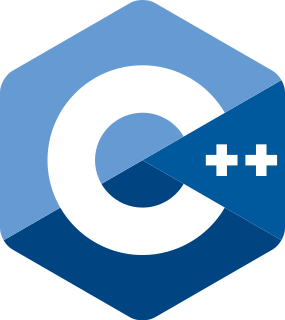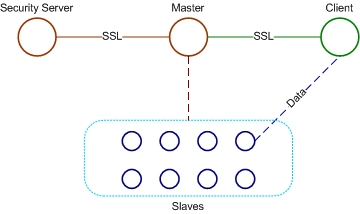Cascading is a software abstraction layer for Apache Hadoop and Apache Flink. Cascading is used to create and execute complex data processing workflows on a Hadoop cluster using any JVM-based language, hiding the underlying complexity of MapReduce jobs. It is open source and available under the Apache License. Commercial support is available from Driven, Inc.
IBM Spectrum Scale is a high-performance clustered file system developed by IBM. It can be deployed in shared-disk or shared-nothing distributed parallel modes. It is used by many of the world's largest commercial companies, as well as some of the supercomputers on the Top 500 List. For example, under its previous name of GPFS it was the filesystem of the ASC Purple Supercomputer which was composed of more than 12,000 processors and had 2 petabytes of total disk storage spanning more than 11,000 disks.
Apache Hadoop is a collection of open-source software utilities that facilitate using a network of many computers to solve problems involving massive amounts of data and computation. It provides a software framework for distributed storage and processing of big data using the MapReduce programming model. Originally designed for computer clusters built from commodity hardware—still the common use—it has also found use on clusters of higher-end hardware. All the modules in Hadoop are designed with a fundamental assumption that hardware failures are common occurrences and should be automatically handled by the framework.

Panasas is a data storage company that creates network-attached storage for technical computing environments.
HBase is an open-source, non-relational, distributed database modeled after Google's Bigtable and written in Java. It is developed as part of Apache Software Foundation's Apache Hadoop project and runs on top of HDFS, providing Bigtable-like capabilities for Hadoop. That is, it provides a fault-tolerant way of storing large quantities of sparse data.

Vertica Systems is an analytic database management software company. Vertica was founded in 2005 by database researcher Michael Stonebraker and Andrew Palmer. Palmer was the founding CEO. Ralph Breslauer and Christopher P. Lynch served as later CEOs.

Apache Hive is a data warehouse software project built on top of Apache Hadoop for providing data query and analysis. Hive gives a SQL-like interface to query data stored in various databases and file systems that integrate with Hadoop. Traditional SQL queries must be implemented in the MapReduce Java API to execute SQL applications and queries over distributed data. Hive provides the necessary SQL abstraction to integrate SQL-like queries (HiveQL) into the underlying Java without the need to implement queries in the low-level Java API. Since most data warehousing applications work with SQL-based querying languages, Hive aids portability of SQL-based applications to Hadoop. While initially developed by Facebook, Apache Hive is used and developed by other companies such as Netflix and the Financial Industry Regulatory Authority (FINRA). Amazon maintains a software fork of Apache Hive included in Amazon Elastic MapReduce on Amazon Web Services.
Data-intensive computing is a class of parallel computing applications which use a data parallel approach to process large volumes of data typically terabytes or petabytes in size and typically referred to as big data. Computing applications which devote most of their execution time to computational requirements are deemed compute-intensive, whereas computing applications which require large volumes of data and devote most of their processing time to I/O and manipulation of data are deemed data-intensive.

HPCC, also known as DAS, is an open source, data-intensive computing system platform developed by LexisNexis Risk Solutions. The HPCC platform incorporates a software architecture implemented on commodity computing clusters to provide high-performance, data-parallel processing for applications utilizing big data. The HPCC platform includes system configurations to support both parallel batch data processing (Thor) and high-performance online query applications using indexed data files (Roxie). The HPCC platform also includes a data-centric declarative programming language for parallel data processing called ECL.
RCFile is a data placement structure that determines how to store relational tables on computer clusters. It is designed for systems using the MapReduce framework. The RCFile structure includes a data storage format, data compression approach, and optimization techniques for data reading. It is able to meet all the four requirements of data placement: (1) fast data loading, (2) fast query processing, (3) highly efficient storage space utilization, and (4) a strong adaptivity to dynamic data access patterns.

A data grid is an architecture or set of services that gives individuals or groups of users the ability to access, modify and transfer extremely large amounts of geographically distributed data for research purposes. Data grids make this possible through a host of middleware applications and services that pull together data and resources from multiple administrative domains and then present it to users upon request. The data in a data grid can be located at a single site or multiple sites where each site can be its own administrative domain governed by a set of security restrictions as to who may access the data. Likewise, multiple replicas of the data may be distributed throughout the grid outside their original administrative domain and the security restrictions placed on the original data for who may access it must be equally applied to the replicas. Specifically developed data grid middleware is what handles the integration between users and the data they request by controlling access while making it available as efficiently as possible. The adjacent diagram depicts a high level view of a data grid.

Apache Drill is an open-source software framework that supports data-intensive distributed applications for interactive analysis of large-scale datasets. Drill is the open source version of Google's Dremel system which is available as an infrastructure service called Google BigQuery. One explicitly stated design goal is that Drill is able to scale to 10,000 servers or more and to be able to process petabytes of data and trillions of records in seconds. Drill is an Apache top-level project.

Oracle NoSQL Database is a NoSQL-type distributed key-value database from Oracle Corporation. It provides transactional semantics for data manipulation, horizontal scalability, and simple administration and monitoring.
Apache Impala is an open source massively parallel processing (MPP) SQL query engine for data stored in a computer cluster running Apache Hadoop. Impala has been described as the open-source equivalent of Google F1, which inspired its development in 2012.
A distributed file system for cloud is a file system that allows many clients to have access to data and supports operations on that data. Each data file may be partitioned into several parts called chunks. Each chunk may be stored on different remote machines, facilitating the parallel execution of applications. Typically, data is stored in files in a hierarchical tree, where the nodes represent directories. There are several ways to share files in a distributed architecture: each solution must be suitable for a certain type of application, depending on how complex the application is. Meanwhile, the security of the system must be ensured. Confidentiality, availability and integrity are the main keys for a secure system.

Apache Phoenix is an open source, massively parallel, relational database engine supporting OLTP for Hadoop using Apache HBase as its backing store. Phoenix provides a JDBC driver that hides the intricacies of the noSQL store enabling users to create, delete, and alter SQL tables, views, indexes, and sequences; insert and delete rows singly and in bulk; and query data through SQL. Phoenix compiles queries and other statements into native noSQL store APIs rather than using MapReduce enabling the building of low latency applications on top of noSQL stores.
Presto is a high performance, distributed SQL query engine for big data. Its architecture allows users to query a variety of data sources such as Hadoop, AWS S3, Alluxio, MySQL, Cassandra, Kafka, and MongoDB. One can even query data from multiple data sources within a single query. Presto is community driven open-source software released under the Apache License.

Apache Ignite is an open-source distributed database, caching and processing platform designed to store and compute on large volumes of data across a cluster of nodes.











